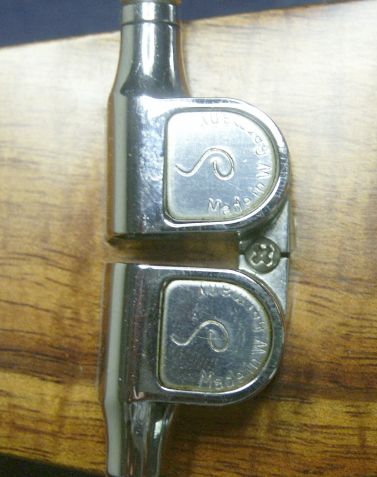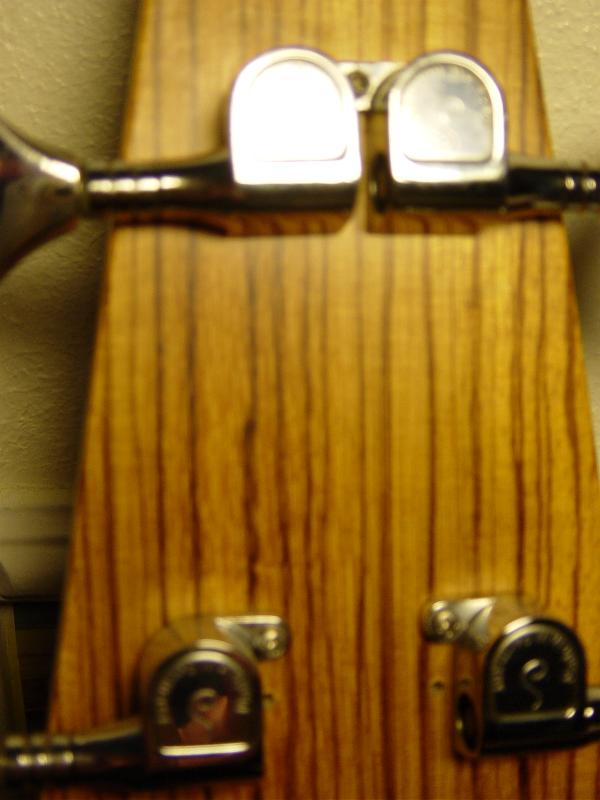| Author | Message | ||
| keith_c
New Username: keith_c Post Number: 1 Registered: 6-2005 |
Had my spoiler for many years (since '92). I enjoy the rock solid feel and resonance! A Fender Strat, Gibson ES-347 and a Yamaha Classical are my first loves. Bass has been secondary so I don't know as much about equip/parts etc... Has any one out there had problems with the tuners on a Alembic? The center two tuners (for A & D strings) are made togther with a very small bridge in which the mounting screw is placed. A while back I had tuning problems so I inspected the tuners and found that the small bridge connecting the center tuners together broke across the screw hole and were floating. Seems to me this is a design problem (weakness). Are there replacement tuners from Alembic that have additional screws or are redesigned to adress this weakness? | ||
| adriaan
Senior Member Username: adriaan Post Number: 568 Registered: 6-2002 |
This is the standard way in which they mounted Schaller tuners on cone pegheads. The lip for the screw on the Schallers is in an awkward position for two closely opposing tuners on this type of peghead, so either the people at Alembic must have cut the lip in half, or Schaller made them that way. Not sure if you're describing the same thing, or that the "lip" really is broken on your tuners? The tuners are fine on my 88 Spoiler. The regular issue Gotohs have the lip for the screw pointing the other way, so they don't have the same problem. | ||
| davehouck
Moderator Username: davehouck Post Number: 1943 Registered: 5-2002 |
Hi Keith, welcome to the group. This is the first time someone in our forum has reported such a problem. In fact, until your post, I had never really focused on how the two top tuners shared a common mounting screw. Looking at mine, the tuners don't actually appear to be joined; rather, the screw hole for each appears to have been carefully cut in half so they can be positioned to share the same screw. On mine, they don't even appear to touch each other. So, perhaps on yours it may be that the screw has become loose and isn't holding the two tuners in place. Perhaps applying some locktite to the screw threads would help to hold it in place.  | ||
| keith_h
Intermediate Member Username: keith_h Post Number: 101 Registered: 2-2005 |
Keith, Well all I can say is your name will be easy to remember. :-) After seeing Dave's picture I am wondering if the screw hole is stripped. For this you might try gluing in the end of a tooth pick and when dry reinserting the screw. Keith | ||
| mica
Moderator Username: mica Post Number: 2541 Registered: 6-2000 |
The tuners are Schaller type on your bass. These were modified slightly since they changed the anchor screw from the bottom of the tuner to the inside edge. It's not likely that your tuners are actually broken, but that in the over 20 years since the bass was made the wood compressed enough to allow the tuners to pull in the rotation of the string tension. What you likely need to do is to fill the original hole with a toothpick or two dipped in regular ol' titebond glue. After the glue dries, you can drill a 1/16" pilot hole for the anchor screw. If the anchor screw is stripped we can mail you a replacement. | ||
| sfnic
Member Username: sfnic Post Number: 77 Registered: 3-2005 |
(To expand on Adrain and Mica's posts slightly): The individual Schaller pegs come with a complete tab for the mounting screw. This tab is about 7/32" long, and has a single thru-hole for the screw. Mounting two of these pegs in the A and D positions--at the same distance from the nut--on the cone peghead would force these two tabs to overlap. Alembic grinds the end of the tab off, leaving 1/2 of the thru-hole. This forms a "U" shaped opening at the end of the shortened tab. Placing two of these modified pegs together forms a complete thru-hole, "cradled" by these two 1/2 tabs. A single screw is then used to hold both pegs in place. This is what you're seeing in Dave's photo, above. Actually, the pegs are attached to the peghead by the shaft ferrules that slide over the string posts and then screw into the peg body. (This is why the ferrules have a hex head.) The smaller screw through the tab is an "anti-rotation" feature that prevents the entire peg from spinning in the hole when you tighten the string. Alembic's manufacturing tolerances are precise enough so that it's often extremely difficult to see the joint between the ground-off ends of the tabs. Over time, however, it's possible for one or both pegs to rotate very slightly (as in, .010" or so) and thus open up that joint very slightly. It shouldn't be a problem as long as the anti-rotation screw itself is still secure in the peghead. The "U" channel of the ground-off tab is still captive to the screw shaft, so the peg is still prevented from rotating. To close the joint gap, simply loosen _one_ of the peg ferrules _very slightly_, (it doesn't matter which one) and rotate that peg to close the gap. Then re-tighten the ferrule. You probably won't need to tighten the anti-rotation screw, but check it anyway. Btw., this mounting arrangement (and the required modification to the peg) isn't unique to Alembic. Any bass builder using a symetrical 2/2 peg arrangement with a "straight string path" head geometry runs into it, and generally solves it the same way. The string-to-string distance is such that the clearance between the inner edges of the string posts dictates the position of the peg bodies. This is true of "small-body" Schallers, Gotohs and any of their clones, but not for pegs like the "Fender-style" pegs, which are simply too large to be used in that configuration. If you use the larger pegs, you have to go to a "fan" arrangement for the strings, from the nut to the peg. There are several schools of thought on the peghead fan: one school says that a having the strings run straight over the nut to the peg provides maximum coupling of the string to the nut, while the other school says that the thrust differential between a straight path and a fanned path are negligible, especially since the string is already changing aspect by the peghead angle. Note that various Alembic pegheads use different spreads; in general the original feeling was that with a neck-through it didn't make enough difference to matter, but with a set neck or a bolt-on it was more of an issue. Overall, though, it's usually more of an aesthetic consideration, though there are builders who will get quite passionate over the issue. (For instance, amongst "boutique" 6-string builders, it's a factor in the ongoing "Strat vs. Les Paul" battle.) One final consideration: Lateral movement of the nut. A set of strings does not necessarily exert the same tension from string-to-string. In some cases, with a "fan" path, the lateral tension through the nut is greater on one side than on the other, because the strings on that side are under greater tension. If the nut was floating, it'd slide towards the tighter side, to equalize the tension. Many builders don't mechanically mount the nut to the neck, but rather use a spot of glue to hold the nut in place. This is usually enough to prevent side-to-side shifting. However, this lateral tension can also show up in the neck-to-body joint of a set neck or bolt-on, causing instability. This is usually trivial, but can sometimes become a sonic issue, leading to dead spots on the neck, truss rods that are harder to adjust than necessary, or, in extreme cases with sloppy designs, shifting of the neck in the pocket. Maintaining a straight-across path all the way to the peg eliminates much of the problem. What residual lateral stresses there are are negligible on the truss rod, and shouldn't affect a well-designed neck-to-body joint at all. Until you start getting into 6 or 8-string basses. There, the lateral tension is much more pronounced, so the peghead engineering is that much more critical. Alembic has totally avoided the problem by physically bolting the nut to the neck. This coupling, along with the laminated neck construction and dual truss rods, essentially eliminates lateral tension as a factor in even "extreme" multi-string designs. Yes, there is still a side-to-side tension differential, but the support beam structure with the fixed end-point coupling reduces the ratio of lateral to linear stress to a very trivial number, which can be disregarded when doing structural analysis of the string support and harmonic nodal performance. nic | ||
| keith_c
New Username: keith_c Post Number: 2 Registered: 6-2005 |
Thanks for your input! Now I know the deal with the Schaller tabs ends being ground back to fit (DUH). However, according to the pic above, and please correct me if I'm wrong, the string tension would cause rotation of the peg so that the screw tabs on the tuner would pull away from each other. To be honest, several years ago I simply flipped the tuners so that the screw tabs are pushing into each other. This did elimenated the tuning problem but the tuners work in reverse (very odd feeling when tuning in wrong direction). I'll try some of these suggestions to 'tune with an appropriate direction'.  | ||
| jlpicard
Advanced Member Username: jlpicard Post Number: 210 Registered: 7-2002 |
Whoa! Keith, you've got more guts than I, drilling holes in your Alembic! I hate to see empty holes in an Alembic for any reason. They are such "wooden works of art". How about some little MOP or brass dot inlays? Mike | ||
| keith_c
New Username: keith_c Post Number: 3 Registered: 6-2005 |
Sorry to alarm you, Mike. Sound and utility first! Looks second! Being a poor public school teacher with a family to support, I sometimes must make do with my on ingenuity avoiding unneeded expenses. Call me 'cheap' if you must. I do like the brass inlay idea. Maybe once I sort out the tuning issue, I will 'inlay' myself or maybe even the spoiler. | ||
| mica
Moderator Username: mica Post Number: 2547 Registered: 6-2000 |
I've always thought that even another anchor screw in the surplus hole looks okay. James and I were discussing making a new alteration for the Schaller tuners specific to the Spoilers with and interlocking cut so the tuner anchors hold eachother. You can also convert to Gotoh tuners, which have the anchor screw on the bottom. Their mounting hole is larger, so you have to redrill the peghead holes. Plus then you still have the extra hole issue. There are many options in Alembicland of course. | ||
| keith_c
New Username: keith_c Post Number: 4 Registered: 6-2005 |
Mica, I just checked out he Gotoh Schaller style tuners. I like the screw tab placement. I think I will go with them and then inlay the empty screw holes. Thanks for the tip! Keith |